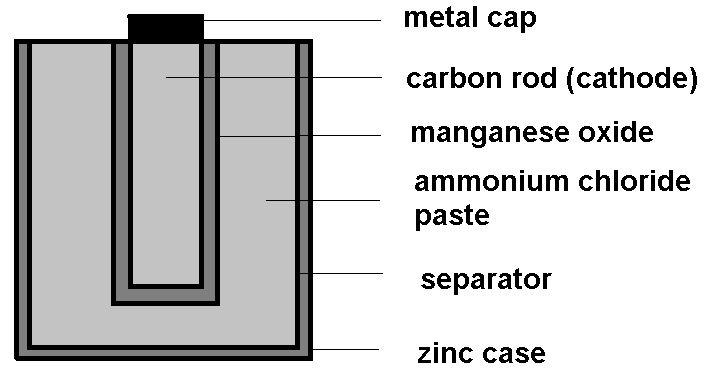
Describe the construction, working and usefulness of a dry cell, with the help of a diagram.
Answer
558.6k+ views
Hint: You could recall what exactly a dry cell is. Then you could explain the basic structure of this dry cell and you could make a neat diagram of this cell. You could then describe its working without going deeply into the chemical reaction part. Also, mention the use of a dry cell.
Complete solution:
In the question, we asked to describe the construction, working and also the usefulness of a dry cell with the help of a diagram.
Basically, a dry cell could be categorized as a type of electric battery that can be commonly used for portable electrical devices. A commonly used dry cell is the zinc carbon cell or the dry Leclanche cell.
The basic structure of a Leclanche cell consists of a zinc anode and a carbon cathode. It uses ammonium chloride as electrolyte in the form of paste. There is also a second paste present in the cell which is a mixture of ammonium chloride and manganese dioxide where manganese dioxide acts as a depolarizer.
The basic structure of a dry cell is given by,

The working of this cell is based on the chemical reactions that take place in it. As the result of these reaction electrons are being built up at the anode which further results in potential difference between the cathode and the anode. As a result of this potential difference the electrons are able to flow through the circuit.
These are the batteries used in portable electrical devices.
Note:
The dry cells are further categorized into primary cells and secondary cells. The primary cells are not rechargeable, that is, the chemicals present in them get used up and cannot be used after that. So they are disposed of in such a condition. Secondary cells are known to be rechargeable and thus can be used many times.
Complete solution:
In the question, we asked to describe the construction, working and also the usefulness of a dry cell with the help of a diagram.
Basically, a dry cell could be categorized as a type of electric battery that can be commonly used for portable electrical devices. A commonly used dry cell is the zinc carbon cell or the dry Leclanche cell.
The basic structure of a Leclanche cell consists of a zinc anode and a carbon cathode. It uses ammonium chloride as electrolyte in the form of paste. There is also a second paste present in the cell which is a mixture of ammonium chloride and manganese dioxide where manganese dioxide acts as a depolarizer.
The basic structure of a dry cell is given by,

The working of this cell is based on the chemical reactions that take place in it. As the result of these reaction electrons are being built up at the anode which further results in potential difference between the cathode and the anode. As a result of this potential difference the electrons are able to flow through the circuit.
These are the batteries used in portable electrical devices.
Note:
The dry cells are further categorized into primary cells and secondary cells. The primary cells are not rechargeable, that is, the chemicals present in them get used up and cannot be used after that. So they are disposed of in such a condition. Secondary cells are known to be rechargeable and thus can be used many times.
Recently Updated Pages
Which cell organelles are present in white blood C class 11 biology CBSE

What is the molecular geometry of BrF4 A square planar class 11 chemistry CBSE

How can you explain that CCl4 has no dipole moment class 11 chemistry CBSE

Which will undergo SN2 reaction fastest among the following class 11 chemistry CBSE

The values of mass m for which the 100 kg block does class 11 physics CBSE

Why are voluntary muscles called striated muscles class 11 biology CBSE

Trending doubts
The computer jargonwwww stands for Aworld wide web class 12 physics CBSE

Dihybrid cross is made between RRYY yellow round seed class 12 biology CBSE

What is virtual and erect image ?

How much time does it take to bleed after eating p class 12 biology CBSE

How did Reza Pahlavi differ from Ayatollah Khomein class 12 social science CBSE

Methyl ketone group is identified by which test A Iodoform class 12 chemistry CBSE




